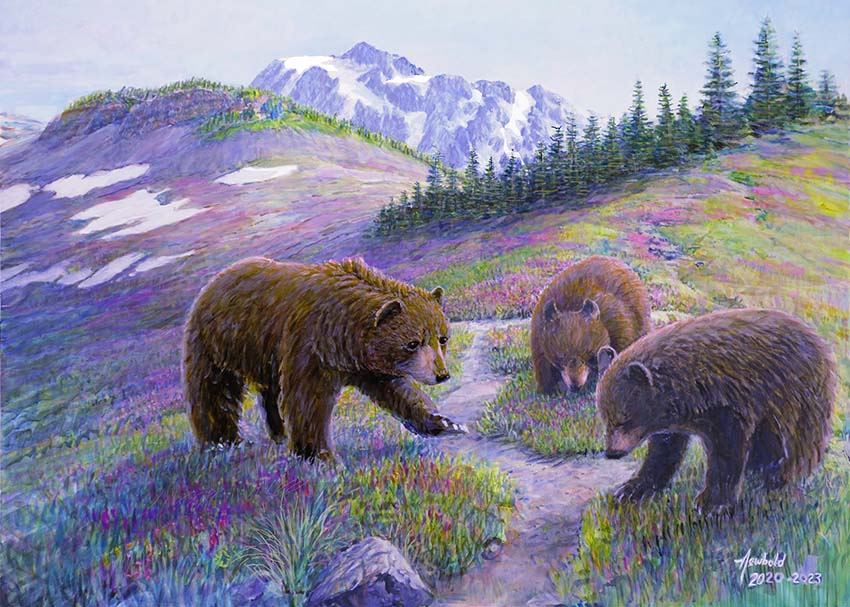
18 Nov A Green’s lonely dissent on bringing Grizzlies to the Cascades
posted November 18, 2023 from Seattle, WA
The weight of the Environmentalist movement appears so far to have been thrown almost unanimously on the side of the plan to slowly reintroduce Grizzly Bears into the North Cascades National Park. And the plan appears to be becoming a fait accompli, with the superintendent of the North Cascades National Park saying in a press release: “This is a first step toward bringing balance back to the ecosystem and restoring a piece of the Pacific Northwest’s natural and cultural heritage.”
Environmentalists have cited both the need to help Grizzlies survive but also the importance of apex predators in bringing about a balance to the ecosystem. An internet commenter making this point referenced the re-introduction of wolves into Yellowstone: “The improvement there is too big to fit in a short post…The short of it is it had a huge beneficial change in the ecosystem. Improving tree growth, erosion and herd health of prey species.”
Not everyone is on board
The opposition has been vocal, however, strongest generally among Republicans but also particularly among the people who live closest to where the big Bears would be released. An article by Jackie Kent, KOMO News Reporter from Nov 6 of this year reports that, “Opponents of the proposal to reintroduce the bears have plastered signs around the small town of Darrington that say, “Hell no to grizzlies.” Some people told KOMO News it would be too dangerous for people living nearby, livestock, and salmon.”
Kent goes on to quote a Darrington man, David Lenon, as saying
“A lot of us are hikers here and we don’t want grizzly bears on our trails.” added David Lenon of Darrington. More has been said along these lines about the plan, not all of it quotable.
As for me, I have 5 points I’d like to make:

Around the Purple Heather. Painting by Ed Newbold. Black Bear mother with two cubs in the North Cascades, with Mt. Shuksan in the distance.
#1
Few US Mammals (other than Bats) are at serious risk of actual full-out extinction. Many Birds (and species from certain other groups) are at imminent risk.
As for me, I’d like to make three points that I feel are mostly not being made. The first is that most Mammals generally are not at serious risk of extinction, (with the exception of Bats, which in a morphological sense are “birds”.) Grizzly Bears are present in a fair part of their original range; their near-term extinction could only come from an Earth-shattering catastrophe. But Birds are in a very serious and time-critical way, so herculean efforts should be reserved for them, along with the other highly at-risk groups (such as Frogs and Salamanders, Bats and various Invertebrates.) Migratory and insectivorous Birds are at particular risk as the 6th Extinction unfolds, but so are many other classes of birds, particularly grassland and prairie birds and now even shrubland-birds like the Sage Grouse.
Washington state has already lost the Upland Sandpiper, the Yellow-billed Cuckoo, the California Condor and probably many others to complete statewide extermination.
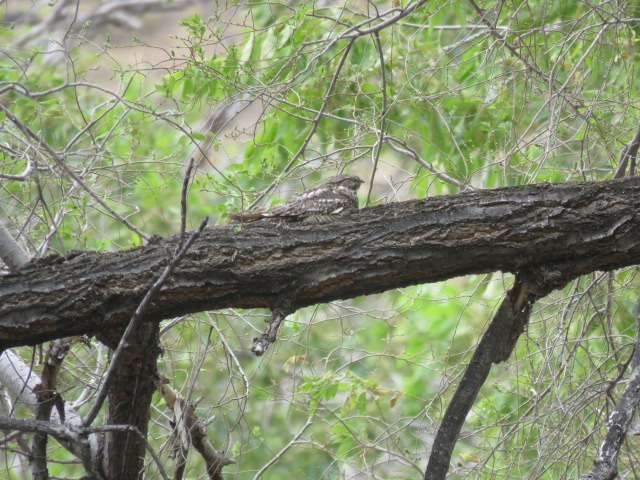
A Common Nighthawk resting in 2023 in a canyon adjoining the Columbia River in lowland Eastern Washington. This bird used to be present in the summer in every Seattle Neighorhood. I heard one calling in the sky above the 1981 Torchlight Parade on 4th Ave, and heard them in every neighborhood I visited at night in my early years here (1976-1982). Now they are very difficult or impossible to find anywhere near Seattle in their breeding season. Photo by Ed Newbold.
#2
Mammals can be rescued when they are at the point of extinction. Many Birds can’t be.
Another reason to triage against helping Mammals is that the situation with Mammals is rarely dire in the way it would be with any number of Bird species, were their populations to collapse. Mammals can be rescued with captive breeding programs when necessary. Pygmy Rabbits are an example of a Mammal that has reached a point of extreme danger of extinction. But when this moment nears for land-based Mammals, we can breed them as the Agencies are heroically doing for Pygmy Rabbits. Not so for birds. Birds and certain other species groups cannot be thrown into cages. One of the birds that I worry about in Washington state is the Common Nighthawk. The Nighthawk has already been extirpated in this state from the urbanized westside lowlands, which is to say almost the entire west-side lowlands, and is declining in the eastside lowlands. If the Nighthawk population were to collapse statewide or nationwide at some point due to disease, low insect-loads, a newly enabled nest predator, extreme drought or some other factor, we would not be able to throw them in cages and breed them. I wasn’t able to find estimates for how far a Nighthawk flies every day. Might it be 40 miles a day? You can’t make a cage for a bird with a lifestyle like that, and then you have to throw in migration and the many dangers that present and the inability for an animal that is caged to migrate.
The relevant agencies love to work with charismatic big Mammals. Humans, being Mammals, have a pro-Mammal bias. Bears are from an evolutionary standpoint just big dogs and we understand them intuitively. The agencies get more ink when they work with Bears than they would were they to work to save the wintering habitat of the Olive-sided Flycatcher, a bird that is in steep decline but that has never had a PR budget at all.
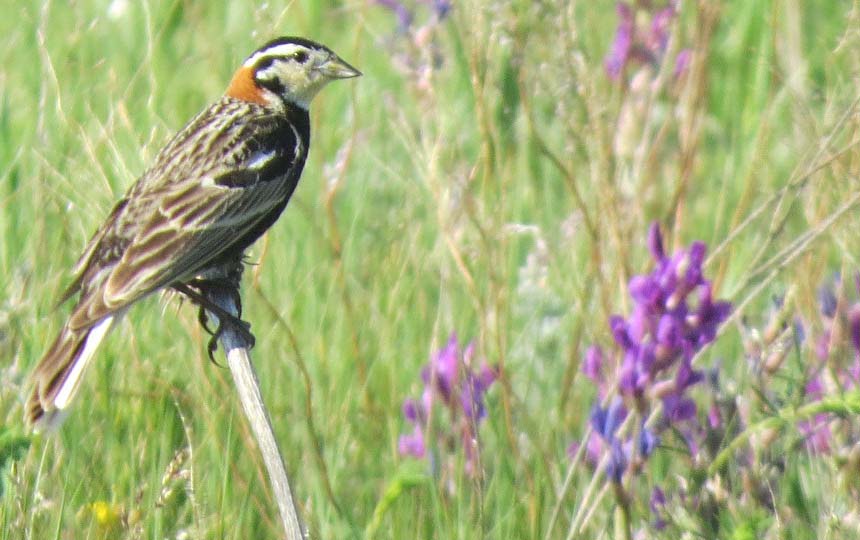
Prairie birds are among the hardest-hit of all American birds. The Chestnut-collared Longspur shown here took a huge hit when the Ethanol mandate was adopted. In Washington, Grasshopper Sparrows, Western Meadowlarks, Bobolinks, “Streaked” Horned Larks and others have declined severely. Photo by Ed Newbold
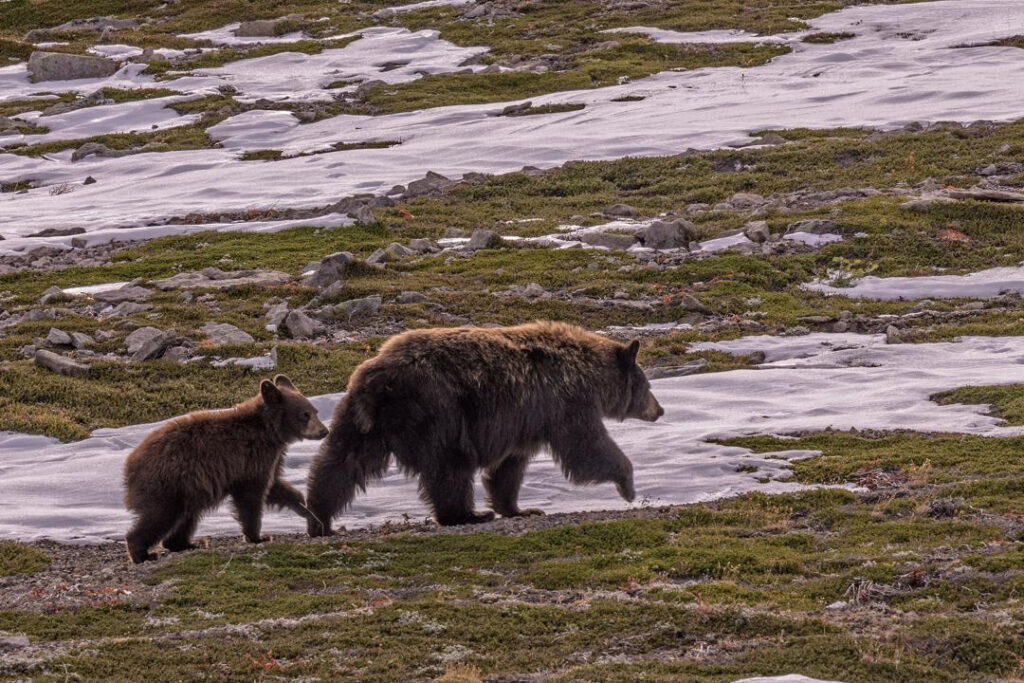
This is a photograph of a Mother Black Bear and a Cub in the North Cascades taken by my friend Rick Droker, the great photographer and lichenologist. I have not yet contacted Rick for permission to put this photo here and will take it down if there is a problem. I have also not researched my contention that the Black Bears of the North Cascades are a bit different from the ones in New Jersey, Pennsylvania or Louisiana or even New Mexico, but when I look at this Bear it has the feel of a bigger critter than the ones I’ve seen or seen in photos from those areas.
#3
The North Cascades do not provide especially great Grizzly habitat.
I am not a biologist and have no relevant credentials here to make this point, but it’s something that is obvious if you drive over Highway 20. The North Cascades are not particularly great Grizzly Bear habitat and in my opinion, the Black Bear already performs some of the functions that Grizzlies would provide there. Black Bears in the North Cascades seem to “dress themselves” to make the point. They are usually brown like a Grizzly, sometimes appear to even have a shoulder-hump, are big and are quite comfortable in the alpine zone there. Unlike Wolves, Grizzlies that have been a short distance across the border have been slow to recolonize the American side. This is no doubt partly because this species is a very slow reproducer, but it is in sharp contrast to Gray Wolves that quickly colonized habitat that is reasonably ideal for them south of the border. Gray Wolf packs now range the eastern slope of Kittitas County for instance, having gotten their on their own, perhaps because of the “vacuum” effect of unoccupied good habitat that was there but may not exist to the same degree for Grizzlies in the Canadian Cascades. Unlike classic Grizzly habitat, the North Cascades are full of exceedingly rough and steep terrain that is intermingled with large amounts of taiga forest and open rock. Black Bears, in a very rough sense are animals of the Taiga, Grizzlies animals of the tundra/alpine zone. The Sierra Nevada of California, where sadly Grizzlies have been exterminated, and places like Yellowstone have large uninterupted areas of loping Alpine meadow and this is where you would paint Grizzlies; where they are “happiest.”
#4
The danger to people should be a factor and the risk is ever-changing and not static
At the risk of appearing to jump sides, I would like to point out that the opponents have one important thing right. The danger of attacks from large carnivores is often portrayed as a static probability, a number that can be derived as a statistic based on historical averages. But this is a misconception that disrespects these animal’s intelligence and denies the fact that all these species have a ‘culture.’ In 1964 in rural Pennsylvania I walked out of our house and saw a Crow. I walked toward it a bit and it saw me and immediately flew out of sight. It was about 600 feet away from me at the time. The Crow was not in danger from me but was enculturated to flee from Humans at that distance. Now in Seattle and places in Pennsylvania a Crow would debate flying away at 20 feet. Animal cultures change, and they change radically, based on the collective experience of the animal, with animal Mothers and parents passing on cultural knowledge to the kids similar to ways that we do.
The way Humans present to animals has been changing radically since about the 60s. When I arrived in Washington in the mid 70’s, trash-shooting was a huge issue for Bald Eagles, Red-tailed Hawks and Peregrine Falcons. In the interim it has all but disappeared, and it represents a massive change in the way Humans present themselves to many species of wildlife. To think that the large Carnivores wouldn’t notice this change is akin to calling them stupid. I am a Green and I want these large carnivores to be part of the eco-system, but ironically, making naive predictions about how many humans they will, might or could attack can be the very thing that ultimately undermines this goal.
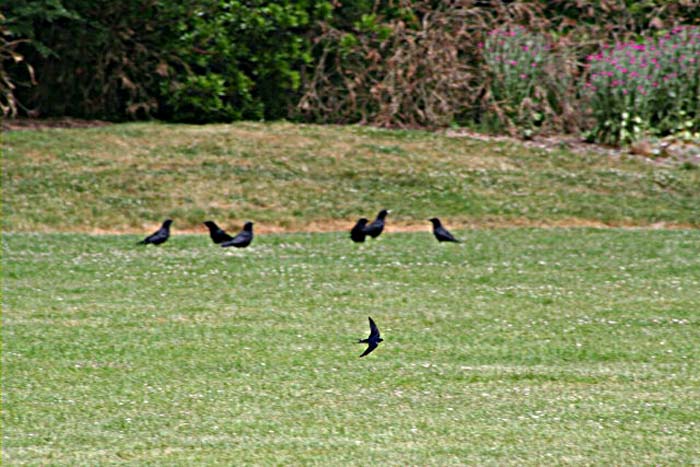

Barn Swallows collapsed–they didn’t decline, they collapsed– in Seattle from about 2008 to 2021 and remain mostly absent from the city when they were very abundant. It was normal to see them in many, many places around the city; the top photo is of one foraging low over the grass at Seward Park. Their sudden absence from our city has gone unnoticed. Something that is disturbing is that it also hasn’t been studied. Ask anyone who thinks about these things and they could give you ten factors that may have contributed or been responsible for their degeneration but they will not be able to order those factors, so you really won’t know anything more than you did before you asked. Species collapsing like this is the bacdrop as our agencies focus on attention-getting gimmicks like bringing big scary Bears in in trucks and releasing them.
#5
America is about to make a decision: to throw away Democracy and embrace Fascism or to stick with the legacy of people like George Washington. The Grizzly decision will be a factor.
I’m a Nextdoor-Warrior here in Seattle. I like to throw in my two cents in favor of Urban Wildlife whenever it comes up for discussion. I find it interesting that Seattleites, while they are electorally-comfortable with foisting Gray Wolves and Grizzlies on the people of Pend O’Reille County, are by no means entirely comfortable living with Coyotes, which can be found in all Seattle neighborhoods but are not yet at carrying capacity in my opinion. Coyotes can be quite scary, they have sharp teeth, but let’s face it, they might as well be Cottontail Rabbits next to a Grizzly or a pack of Gray Wolves.
But the rights of Coyotes are actually quite controversial on Nextdoor. And the allies of the Coyotes include the Humane Society and the Human Society doesn’t waste time with romantic pieties about them. In an effort to defend the Coyotes and build the basis for a long term acceptance of them by the population,The Humane Society asks people to almost go to war with them, recommending that we “haze” Coyotes and work diligently to make them afraid of Humans, and they give us ways to do that. This is, in my opinion, a credible approach to building a long-term coexistence with with this animal.
I am pro-Creature, that means Pro-Coyote. But what I fear is that when some Coyote makes a big mistake and is captured on film killing and eating something it shouldn’t have, many of the folks in the Pro-Coyote-Silent-Majority will melt away. And the comforting statements that various zealous Coyote advocates have made, particularly romantic things we may have once said about Coyotes, will be thrown in all of our faces. The past does not predict the future.
The Dingo story in Australia is a shot across the bow. Everyone thought that a a human mother had killed her baby and then blamed a Dingo (a Wild Dog species of Australia some what larger and stronger than a Coyote but not as big or dangerous by any means as a pack of Wolves). They thought a Dingo would never do such a thing. When forensics ultimately resolved the mystery, the Mom was finally released from years of living under the weight of bullying and harassment of an entire continent.
When we assure people that “Orcas (or Wolves, or this species or that species) don’t attack humans,” we are actually disrespecting these animals. They are smart and capable—science is constantly and belatedly catching up with how smart animals are—and why wouldn’t they? Wolves in a sense may be designed to be “human-specialists” in the way a Canada Lynx is a “Snowshoe-Hare-specialist.” In the 1300s, Wolves returned to the suburbs of Paris after a particularly bad Plague outbreak had reduced the human population by a third, which had in turn reduced the collective ability of humans to defend themselves against this smart and strong animal (this story from the book A Distant Mirror by Barbara Tuchman).
What I’m saying is we owe the people who live in places like North-central WA a little bit of consideration. We were having a lovely breakfast in Metaline Falls at an outdoor café. When the folks at the neighboring table found out we were from Seattle, in their next breath they asked us if we could take their Wolves back to our fair city. They knew we were pro-Wolf. A man from Idaho told me his two young children, nine and twelve, had to walk through a mile of woods to get to their Schoolbus stop. Wolves and Bears (and I suppose Cougars) were on his mind in a way they just aren’t for us here in Seattle.
For the folks who live in places like Stevens County, it’s very easy to see the whole Grizzly affair as something that is barely cared about in Seattle, barely debated, and the pro-bear majority may be a mile wide but barely an inch deep and yet the people who will have to deal with the actual Bears–not all these barely’s, are the ones in Stevens County who do have skin in the game.
This doesn’t mean a war on predators, it doesn’t mean a lot of things. These critters were here first and they have hard and fast rights in my opinion. But maybe when there is an optional political move that may not be the right one anyway because other things need to be prioritized, and one that while being supported in a lukewarm way by the majority is absolutely hated virulently by those who would be most affected, maybe we should back off.
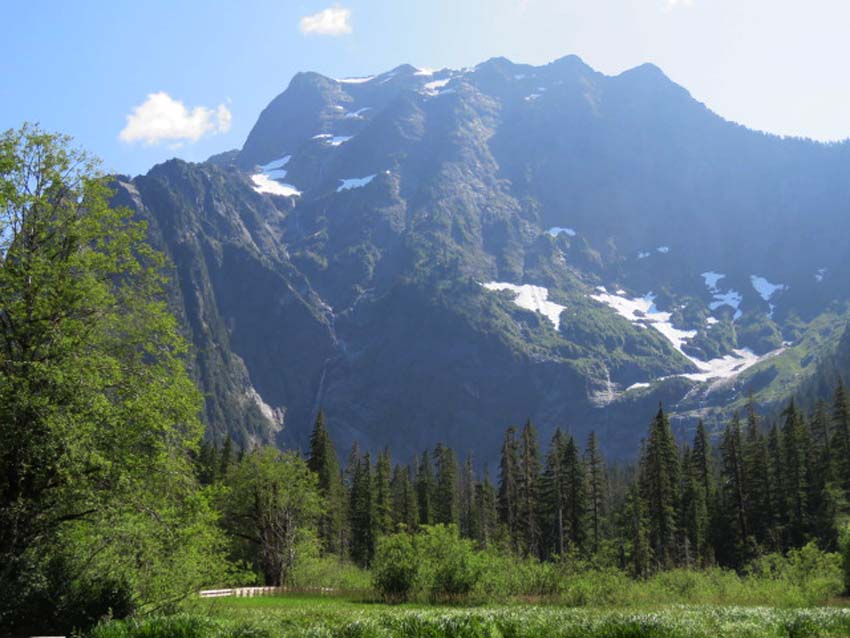
Big Four Mountain at the southwestern edge of the North Cascades. Rugged indeed.
the Bear, The Bear jumped away in surprise, that was all.

Sorry, the comment form is closed at this time.